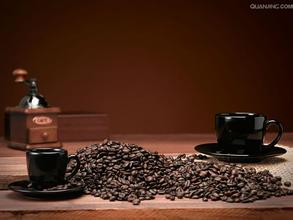Introduction to the description of Brand Price, taste and Flavor of Brazilian Yellow Bourbon Rivida Coffee Bean location conditions
Introduction to the description of Brand Price, taste and Flavor of Brazilian Yellow Bourbon Rivida Coffee Bean location conditions
The sweet feeling is a high quality with good quality and low price.
The "bourbon" in Bourbon Santos, Brazil comes from the Bourbon Indian Arabica Coffee Tree. The island of Bourbon, now known as Reunion, was once a thriving place for Arabica coffee. Arabik coffee trees grown on the island were introduced around the world, and Brazil's Bourbon Santos is their descendant. Sandoz comes from the port of Sandoz, a port in the Atlantic Ocean in southeastern Brazil. Among the coffee exported from the port of Santos, there are Brazilian coffee from different producing areas, and the more guaranteed quality comes from the southern states of Sao Paulo, Parana and Minas Gerais, of which Minas Gerais has the best quality.
In Brazil, because the planting area of coffee is too large and the degree of mechanized production is relatively high, people often harvest ripe and green fruits together, and there is usually no sorting process. Sometimes coffee fruit is mixed with coffee branches and leaves. Not only that, Brazilian coffee beans are sun-dried. Farmers put coffee beans of different maturity together and expose them in the sun, so that coffee beans are mixed with soil and various impurities in the first place. sometimes overripe and rotten coffee fruits can also affect the flavor of coffee beans.
Brazil is vividly compared to the "giant" and "monarch" of the coffee world. There are about 3.97 billion coffee trees there, and small farmers now grow 75% of Brazil's total coffee production. The number of coffee producers in Brazil is twice or even three times that of Colombia, the second largest coffee producer in the world.
Unlike in the past, Brazil's economy is now less dependent on coffee, which accounts for only 8% to 10% of GDP. Before World War II, Brazil accounted for 50% or more of the world's coffee production, and now it is close to 30%. But the country's impact on the world's coffee, especially on coffee prices, is significant. For example, two frost disasters in 1994 caused a sharp rise in global coffee prices.
Since the introduction of coffee trees from French Guiana (Guyana) in 1720, coffee production has gradually become a science. Before 1990, the Brazilian government carried out strict monitoring of the coffee industry, with both strict intervention and price protection measures, and the state has been implementing minimum price protection measures for farmers, resulting in coffee overproduction. Before World War II, the remaining stock reached 78 million bags, which had to be burned by fire or thrown into the water to destroy.
Since the opening of the free market in 1990, the original Brazilian Coffee Authority (IBC) has been replaced by the National Economic Association, the country's non-investment administrative body, which pursues a policy of non-intervention and allows producers to negotiate directly with exporters. The business activities of exporters are supervised by government legislation, and legitimate exporters are registered by the relevant departments.

Important Notice :
前街咖啡 FrontStreet Coffee has moved to new addredd:
FrontStreet Coffee Address: 315,Donghua East Road,GuangZhou
Tel:020 38364473
- Prev

Introduction to the taste of coffee bean producing area of Las Haas Manor in Costa Rica with pure flavor
The pure flavor of Costa Rica's Las Haas Manor Coffee producing region introduces the main competitors of high-quality coffee in Costa Rica are Kenya, Guatemala and Ethiopia. Coffee production in Brazil and Vietnam is mainly in quantity, which is not enough to pose a threat to high-quality coffee in Colombia. In the next five years, my country plans to increase the export volume of high-quality coffee to 70% of all exported coffee. Third,
- Next

An introduction to the description of the flavor and taste of coffee producing areas in the altitude highlands of Honduras
According to the flavor and taste of coffee producing areas in the highlands of Honduras, there are 280000 hectares of coffee gardens in Honduras, mainly small coffee merchants, most of which are less than 3.5ha, which account for 60% of Hongguo's production. In the coffee garden, people collect coffee beans by hand, then handle them carefully and process them to meet the needs of the market.
Related
- Detailed explanation of Jadeite planting Land in Panamanian Jadeite Manor introduction to the grading system of Jadeite competitive bidding, Red bid, Green bid and Rose Summer
- Story of Coffee planting in Brenka region of Costa Rica Stonehenge Manor anaerobic heavy honey treatment of flavor mouth
- What's on the barrel of Blue Mountain Coffee beans?
- Can American coffee also pull flowers? How to use hot American style to pull out a good-looking pattern?
- Can you make a cold extract with coffee beans? What is the right proportion for cold-extracted coffee formula?
- Indonesian PWN Gold Mandrine Coffee Origin Features Flavor How to Chong? Mandolin coffee is American.
- A brief introduction to the flavor characteristics of Brazilian yellow bourbon coffee beans
- What is the effect of different water quality on the flavor of cold-extracted coffee? What kind of water is best for brewing coffee?
- Why do you think of Rose Summer whenever you mention Panamanian coffee?
- Introduction to the characteristics of authentic blue mountain coffee bean producing areas? What is the CIB Coffee Authority in Jamaica?

